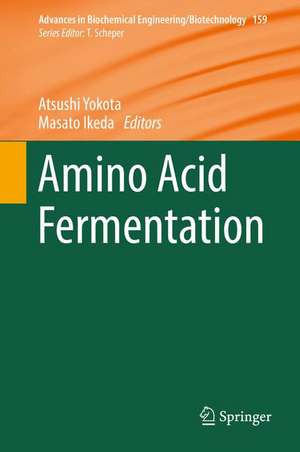Amino Acid Fermentation: Advances in Biochemical Engineering/Biotechnology, cartea 159
Editat de Atsushi Yokota, Masato Ikedaen Limba Engleză Hardback – 18 mai 2017
| Toate formatele și edițiile | Preț | Express |
|---|---|---|
| Paperback (1) | 2089.20 lei 6-8 săpt. | |
| Springer – 29 iul 2018 | 2089.20 lei 6-8 săpt. | |
| Hardback (1) | 2095.35 lei 6-8 săpt. | |
| Springer – 18 mai 2017 | 2095.35 lei 6-8 săpt. |
Din seria Advances in Biochemical Engineering/Biotechnology
-
 Preț: 385.84 lei
Preț: 385.84 lei -
 Preț: 383.12 lei
Preț: 383.12 lei -
 Preț: 383.71 lei
Preț: 383.71 lei - 18%
 Preț: 1220.45 lei
Preț: 1220.45 lei - 18%
 Preț: 1816.43 lei
Preț: 1816.43 lei - 5%
 Preț: 1415.54 lei
Preț: 1415.54 lei - 5%
 Preț: 2113.74 lei
Preț: 2113.74 lei - 18%
 Preț: 1219.16 lei
Preț: 1219.16 lei - 18%
 Preț: 1823.56 lei
Preț: 1823.56 lei - 18%
 Preț: 1219.63 lei
Preț: 1219.63 lei - 18%
 Preț: 1224.18 lei
Preț: 1224.18 lei - 18%
 Preț: 1826.07 lei
Preț: 1826.07 lei - 18%
 Preț: 1836.31 lei
Preț: 1836.31 lei -
 Preț: 383.71 lei
Preț: 383.71 lei - 18%
 Preț: 1821.81 lei
Preț: 1821.81 lei - 18%
 Preț: 1822.57 lei
Preț: 1822.57 lei - 18%
 Preț: 2477.79 lei
Preț: 2477.79 lei - 18%
 Preț: 1817.08 lei
Preț: 1817.08 lei - 18%
 Preț: 2467.38 lei
Preț: 2467.38 lei - 18%
 Preț: 2085.39 lei
Preț: 2085.39 lei - 18%
 Preț: 2082.40 lei
Preț: 2082.40 lei - 18%
 Preț: 1212.84 lei
Preț: 1212.84 lei - 18%
 Preț: 1213.65 lei
Preț: 1213.65 lei - 18%
 Preț: 1815.49 lei
Preț: 1815.49 lei -
 Preț: 388.72 lei
Preț: 388.72 lei - 18%
 Preț: 1814.73 lei
Preț: 1814.73 lei - 18%
 Preț: 939.46 lei
Preț: 939.46 lei - 18%
 Preț: 1820.22 lei
Preț: 1820.22 lei
Preț: 2095.35 lei
Preț vechi: 2555.30 lei
-18% Nou
Puncte Express: 3143
Preț estimativ în valută:
400.99€ • 435.42$ • 336.83£
400.99€ • 435.42$ • 336.83£
Carte tipărită la comandă
Livrare economică 22 aprilie-06 mai
Preluare comenzi: 021 569.72.76
Specificații
ISBN-13: 9784431565185
ISBN-10: 4431565183
Pagini: 310
Ilustrații: VIII, 310 p. 59 illus., 21 illus. in color.
Dimensiuni: 155 x 235 x 19 mm
Greutate: 0.63 kg
Ediția:1st ed. 2017
Editura: Springer
Colecția Springer
Seria Advances in Biochemical Engineering/Biotechnology
Locul publicării:Tokyo, Japan
ISBN-10: 4431565183
Pagini: 310
Ilustrații: VIII, 310 p. 59 illus., 21 illus. in color.
Dimensiuni: 155 x 235 x 19 mm
Greutate: 0.63 kg
Ediția:1st ed. 2017
Editura: Springer
Colecția Springer
Seria Advances in Biochemical Engineering/Biotechnology
Locul publicării:Tokyo, Japan
Cuprins
Part I. Situation and history of amino acid fermentation.- Present global situation of amino acids in industry.- Discovery and History of Amino Acid Fermentation.- Early history of the breeding of amino acid-producing strains.- Part II. Examples of amino acids fermentation.- Glutamate fermentation-2: Mechanism of L-glutamate overproduction in Corynebacterium glutamicum.- Lysine Fermentation – History and Genome Breeding.- Branched-chain amino acids.- L-Cysteine metabolism and fermentation in microorganisms.- L-Methionine Production.- Part III. Recent Advances in amino acid fermentation research.- Boosting anaplerotic reactions by pyruvate kinase gene deletion and phosphoenolpyruvate carboxylase desensitization for glutamic acid and lysine production in Corynebacterium glutamicum.- Exporters for production of amino acids and other small molecules.- Novel technologies for optimal strain breeding.- Microbial production of amino acid-related compounds.- Part IV. Future prospective of amino acid fermentation.- New functions and potential applications of amino acids.- Toward sustainable amino acid production.
Notă biografică
Atsushi Yokota, Ph. D., Professor, Laboratory of Microbial Physiology, Division of Fundamental AgriScience Research, Research Faculty of Agriculture, Sapporo, Hokkaido University
Masato Ikeda, Ph. D., Professor, Department of Agricultural and Life Sciences, Faculty of Agriculture, Shinshu University, Nagano, Japan
Textul de pe ultima copertă
This book presents the latest findings on amino acid fermentation and reviews the 50-year history of their development. The book is divided into four parts, the first of which presents a review of amino acid fermentation, past and present. The second part highlights selected examples of amino acid fermentation in more detail, while the third focuses on recent advanced technologies. The last part introduces readers to several topics for future research directions in amino acid production systems. A new field, “amino acid fermentation”, was created by the progress of academic research and industrial development. In 1908, the Japanese researcher Kikunae Ikeda discovered glutamate as an Umami substance. Then a new seasoning, MSG (monosodium glutamate), was commercialized. Although glutamate was extracted from the hydro-lysate of wheat or soybean in the early days, a new production method was subsequently invented – “fermentation” – in which glutamate is produced from sugars such as glucose by a certain bacterium called Corynebacterium. The topic of this volume is particularly connected in a significant way with biochemical, biotechnological, and microbial fields. Both professionals in industry and an academic audience will understand the importance of this volume.
Caracteristici
Examines updated and comprehensive contents in amino acid fermentation Presents a comprehensive review of an exciting history Is written by authors who are involved in research and development in academia and industry











